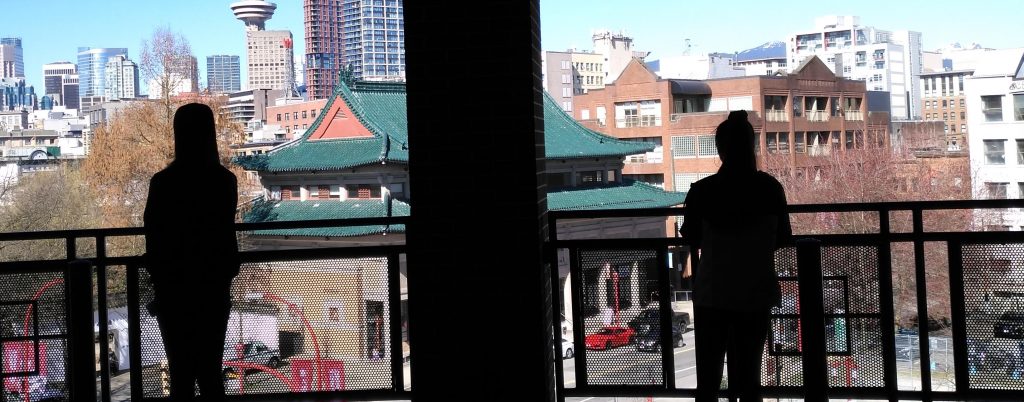I work with youth in the Hastings-Sunrise neighbourhood of Vancouver, and a large majority of these youth are a part of the Cantonese diaspora. Their home lives are close to my own upbringing. They’re growing up in busy three generational houses, within arms reach of their grandparents, or are going to Chinatown to visit their Grandparents in their homes there, just like I did, and just like my Dad did. Weekend trips to Chinatown for congee and egg noodles and soup in the morning, stories and knowledge of Chinatown clan association drama and happenings, and an intricate understanding of where to find the best prices for bakery buns is the norm for these kids. Having come to terms with my own family history in Chinatown, and spending every waking moment trying to reclaim that culture and history apart from people who told me to do otherwise, made me interested in learning about how these youth felt about the neighbourhood of Chinatown. Had they heard about 105 Keefer? What had they heard about Chinatown from their friends? I would ask them about what they were learning in Social Studies, eventually alluding to my own negatively impactful experience learning about the Chinese Head Tax and Chinese migration in school. I would ask them if they were interested in dedicating an after school session to learn about these topics, to some avail.
When Spring Break neared, and an opportunity to set the youth up with volunteer placements in Vancouver came along, I immediately reached out to Qin and Leslie from Chinatown House to see if a couple of days in Chinatown with the youth could be feasible. We planned to use the co-working space as our home base while we were wandering through the neighbourhood, to write stories about our past and present experiences in the neighbourhood, and were set. When the youth came, I led them on a tour around Chinatown and gave them an introduction of the built environment, cultural history, and ongoing efforts to preserve and uplift the important heritage of the neighbourhood. I asked them what their first memory in Chinatown was, how coming back to Chinatown as teenagers made them feel, and what they wish for the future of Chinatown. The stories that two of the youth wrote as a result of this are below. Enjoy!
– Kimberley | 黄壯慈
This project was done in collaboration with Frog Hollow Neighbourhood House and the Youth Skills Program at Vancouver Technical Secondary.
Celine Ta | 謝韻善
Celine is a Chinese-Canadian girl currently in grade 10 at Vancouver Technical Secondary. She is a passionate volunteer, enrolling in several clubs including Key club, WWF club, and Youth Skills. Celine enjoys working with people of all ages, genders, and races to positively impact society in the future. In her free time, she enjoys singing to express herself through music. She wants to share her singing publicly, to help people who struggle with mental health. She devotes much of her time to volunteering for the benefit of others, while also studying at school, where she achieves honour roll. She hopes that her volunteering will help create a better, safer, more inclusive community. Celine feels connected to Chinatown through her regular outings which evoke a sense of belonging for her. She feels connected to the traditional Chinese environment, including the bakeries, dried food stores, and Cantonese language she finds in Chinatown.
My first memory in Chinatown begins with a visit to my grandmother’s home at the age of 4. My mom always dropped me off at her home, situated in a senior residency when she was busy. It was cold and small, but while I was there, I loved to watch her tiny television and that was all that mattered to me. I felt awkward but still satisfied from the Spongebob show every time I went there, as my grandmother never really talked to me and was asleep most of the time. I don’t quite remember the details of this memory, but I wish that I could recall the disease she had that led to her death later on.
Upon coming back to Chinatown to learn about its history and to observe its environment, I felt helpless as a bystander. We toured the streets of the neighbourhood in a way that didn’t really allow us to engage and become a part of the Chinatown community. The new knowledge that I have acquired on this tour makes me feel annoyed by how the white people colonized Canada and held prejudices against the Chinese. This new knowledge agitated me due to the fact that our school curriculum barely acknowledges this dreadful history, instead leaving it as if nothing had happened. Now I see my favourite childhood bakeries and clothing stores slowly disappearing and being replaced by new “trendy” stores that are strongly influenced by white culture. Witnessing this breaks my heart, as my connection to this once comforting Chinese community is now being changed and catered to attract people of white backgrounds.
I wish the future of Chinatown to be a safe space where people of all cultures, ethnicities, and genders are treated equally. However, I would still want to see the authentic Chinese culture here being well preserved and the significant historic stores and nostalgic places remaining here in the future. When I would come to Chinatown with my mom, we would take a moment to appreciate the beautiful variety of flowers and trees as well as the traditional dried food stores, BBQ pork/duck stores, and bakeries; so I hope the City of Vancouver would continue to maintain the history of these places which were and still are staples in the lives of the residents or nearby residents of Chinatown.
When walking around Chinatown now, I feel the most drawn towards and curious about exploring the Dr. Sun Yat-Sen Classical Chinese Garden. I remember when I was little, my mom would always take me to the garden and snap photos with me in the gazebo. We looked at the gorgeous koi fish and calm gazing ducks floating smoothly around the pond. This was a place that helped both me and my mom calm down and connect with the world around us. When we went inside the garden on the tour, I reflected on my previous memories and took the time to appreciate the wonderful place nature has given us. This garden stores many valuable and nostalgic memories in my mind and I now feel an emotional attachment to it.
When I think about the future of Chinatown, I see a bright and lively place filled with diverse people and a clean environment welcoming to everyone. I would feel the light breeze and soft sun against my skin. I’d listen carefully to the faint chirps of newly born birds, the bark of chatty dogs, and people conversing in a variety of languages. I’d pass by warm bakeries and BBQ pork/duck stores, smelling the freshly baked sweet bread and savoury smoked aroma getting stronger as I walked in. I’d eat and savour the delightful cheese buns and BBQ pork with my mom filling my mouth with a pleasant salty, spectrum of flavours.

Celine Ta and Jaedyn Yee stand inside the Chinatown Plaza parkade, looking at the Chinese Cultural Centre
Jaedyn Yee
Jaedyn is a grade 10 student at Van Tech who likes to dance, play the ukulele, and volunteer in her free time. She hopes that her work in the future will positively impact social issues and the people and community she works for. She also hopes to bring awareness to issues that aren’t talked about very often. Her connection to Chinatown stems from when she was younger. She came here a lot to visit her Great Grandma, and to eat the nostalgic and delicious food here. Jaedyn would shop at the stores with her Yeye and big brother, to buy asian pears, white rabbit candies, and other snacks. Chinatown means a lot to her because it represents her connection to ethnicity and heritage. She is fourth generation Chinese-Canadian and her great grandparents came to Canada from Canton and Bangkok, Thailand.
My first memory in Chinatown was going to visit my great grandma at her house where she lived with other elderly people. My brother, grandpa, and I would visit her together. My great grandma was very kind and caring. While we were visiting, she gave my brother and I haw flakes. At this time, I think I was about 5 years old and my brother was 9 years old. I don’t remember too much, but we would usually spend a good 30 to 60 minutes playing. My brother and I always enjoyed going there. This memory is something I look back fondly on. I also can’t remember where her house is, but if I did, I’d like to see how it looks today and I wonder if it’s still there.
When I came back to Chinatown, I felt confused because a lot of the stores I used to know were closing and there were new apartments and stores that I have never seen before. This also made me feel a little bit upset because a lot of these stores weren’t getting the amount of business they used to get anymore. Chinatown holds a lot of history and I think it’s important to keep some of the things here alive because there are things that mean a lot to not just me, but many other people too.
I wish Chinatown were a large community full of all ages, races, ethnicities, and backgrounds being together as one. I would really like to see more people from a variety of generations from all over Vancouver and other communities walking the streets together and being with one another. I would come here with my family to eat a ton of delicious food while walking around Chinatown and listen to all of the beautiful music coming from the buildings. I’d admire all of the architecture that holds so many important events that have happened in the past that have shaped Chinatown into the place that it is today.
Walking around Chinatown, I felt most curious when passing by the bakeries. I wanted to go inside to see all of the delectable pastries that had filled my senses. I longed to find the pastries that my mom and grandpa would always bring home after their trip to Chinatown, such as the coconut buns, apple tarts, and bak tong gao. Whenever I see or taste those yummy treats it always gives me nostalgia of when I was younger and enjoying them.
The future of Chinatown is families being together, laughing and talking with each other while taking strolls down the red and gold strewn sidewalks. The future of Chinatown looks like a bright and radiant day with children running around and playing at the park with each other. But most importantly and above all, the future of Chinatown feels like a safe place made for everyone to appreciate and use for their own gratification.






